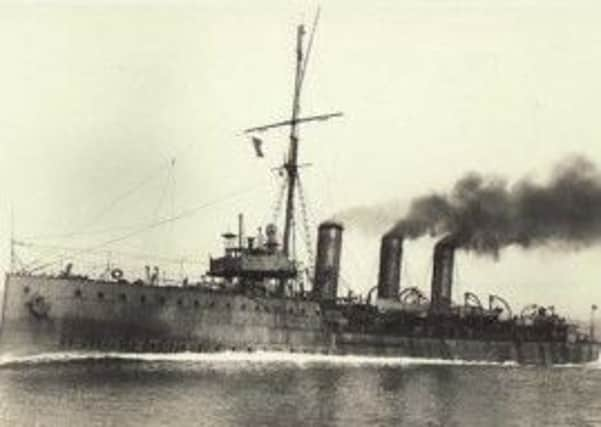The Lurgan seaman who died on HMS Pathfinder 100 years ago


Born on October 18, 1894, the son of George and Sarah Ann Daley, Herbert grew up in Queen St, Lurgan. He had four brothers and four sisters.
He started working as a labourer and carpenter’s apprentice in 1911 at the age of 16 and moved to Milfort Avenue in Dunmurry.
Advertisement
Hide AdAdvertisement
Hide AdHowever on February 25 1913 he enlisted and became Ordinary Seaman Herbert Daley and survived until his ship HMS Pathfinder became the first ship ever to be sunk by a locomotive torpedo fired by a submarine on September 5, 1914.


HMS Pathfinder was sunk off St Abbs Head in the Scottish Borders while on patrol, by U-21 commanded by Kapitänleutnant Otto Hersing, taking with her six men from Ulster.
Despite the event having been easily visible from shore the authorities attempted to cover up the sinking and Pathfinder was reported to have been mined.
The majority of crew below decks had neither the time nor opportunity to escape and went down with the ship.
Advertisement
Hide AdAdvertisement
Hide AdThere was some confusion at the time over the exact number of crew on board, but research indicates that there were 261 deaths and only 18 survivors.
One of these survivors was Captain Francis Martin Leake who had started his career as a young Lieutenant on HMS Caroline. Captain Leake stayed with his ship as she went down by the nose but was lucky to be picked up and saved.
He writes in a letter to his mother; “The torpedo got us in our forward magazine and evidently sent this up, thereby killing everyone forward”.
He says of Pathfinder; “She then fell over and disappeared leaving a mass of wreckage all around, but I regret very few men amongst it, for at the time they were all asleep on the mess decks and the full explosion must have caught them, for no survivors came from forward.”
Advertisement
Hide AdAdvertisement
Hide AdAnother survivor was County Down man, Staff Surgeon Thomas Aubrey Smyth who gave an account of his experiences in a letter to his mother who lived at Bedeque House, Dromore.
“The explosion blew a great hole in the side of the ship. I was at the time in the wardroom, but ran up on deck immediately, and it was then evident by the way the bow was down in the water that she would sink rapidly. I should say the whole thing occurred in about ten minutes which time was spent in throwing overboard the few articles which would float (the reason there was not more of these was that in preparation for war all unnecessary woodwork is got rid of to prevent fire). I was then thrown forward by the slope of the deck and got jammed beneath a gun (which I expect is the cause of my bruising) and while in this position was carried down some way by the sinking ship, but fortunately after a time I became released and after what seemed like interminable ages I came to the surface, and after swimming a short time I was able to get an oar and some other floating material with the help of which I was just able to keep on the surface. After holding on for a long time - I believe it was an hour and a half – I must have become unconscious for I have no recollection of being picked out of the water. You see we were alone when it happened, so it took a long time for the reserve torpedo boats to come out and it was too quick to get any of our own boats out, besides most of the few we had were splintered into pieces.”
Of the 268 crew just 18 are thought to have survived. There were at least six Ulster casualties on board HMS Pathfinder who were all under 28 years old.
None of these men’s bodies were recovered for burial and as such they still remain where they died.
Advertisement
Hide AdAdvertisement
Hide AdRecords show that at around 3.30pm on September 5, 1914, the torpedo detonated beneath the bridge. The cordite charges may have then been ignited, leading to a flash causing a second, massive explosion within the fore section of the ship as the magazine blew up. The fore mast and No 1 funnel collapsed and then toppled over the side. The forensic evidence of the wreck is that everything before the first funnel disintegrated. The majority of the crew below decks in the forward section had neither the time nor the opportunity to escape.
The explosion was seen by British writer Aldous Huxley (while staying at St. Abbs) recorded the following in a letter to his father sent on September 14, 1914: “I dare say Julian told you that we actually saw the Pathfinder explosion – a great white cloud with its foot in sea. The St. Abbs’ lifeboat came in with the most appalling accounts of the scene. The explosion must have been frightful. It is thought to be a German submarine that did it, or, possibly, a torpedo fired from one of the refitted German trawlers, which cruise all round painted with British port letters and flying the British flag.”
All six men are remembered at Chatham Naval Memorial. The wreck site of HMS Pathfinder is designated under the Protection of Military Remains Act 1986.
The anniversary on Friday, September 5 will be marked by the British Sub-Aqua Club who will lay a wreath for the centenary of her sinking.
Advertisement
Hide AdAdvertisement
Hide AdOn the centenary of HMS Pathfinder’s sinking tomorrow, HMS Bangor will arrive in Bangor, County Down. She will be open to the general public on the afternoons of Saturday, September 6 and Sunday, September 7.